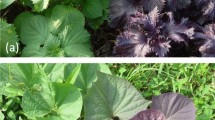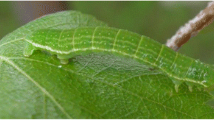Abstract
A recent important paper (Ide, Arthropod-Plant Interact 16:567–581, 2022) reported the experimental testing of two (out of several) of the visual red young leaf anti-herbivory hypotheses: (1) Aposematism by red young leaves; (2) Undermining herbivorous insect camouflage. Ide (Arthropod-Plant Interact 16:567–581, 2022) interpreted his solid experimental results as supporting the aposematic red leaf defence hypothesis, but not supporting the undermining herbivorous insect camouflage. I wish to clarify that because the undermining herbivorous insect camouflage hypothesis has two components: (1) Herbivores refrain from occupying colourful surfaces that do not match their colour; (2) If and when not refraining from occupying them, they are exposed to higher predation and parasitism risks. Thus, Ide’s (Arthropod-Plant Interact 16:567–581, 2022) results seem to support both hypotheses, and not only aposematism. Accordingly, Ide’s (Arthropod-Plant Interact 16:567–581, 2022) results do support the undermining herbivorous insect camouflage hypothesis, especially by exposing the insects that do not refrain from occupying leaves that do not match their colour to higher predation risks.







Similar content being viewed by others
References
Agati G, Guidi L, Landi M, Tattini M (2021) Anthocyanins in photoprotection: knowing the actors in play to solve this complex ecophysiological issue. New Phytol 232(6):2228–2235
Baisden EC, Tallamy DW, Narango DL, Boyle E (2018) Do cultivars of native plants support insect herbivores? HortTechnol 28:596–606
Bates HW (1862) Contributions to an Insect Fauna of the Amazon Valley. Lepidoptera: Heliconidae. Trans Linn Soc Lond XXIII:495–566
Burns KC (2010) Is crypsis a common defensive strategy in plants? Speculation on signal deception in the New Zealand flora. Plant Signal Behav 5:9–13
Coley PD, Aide TM (1989) Red coloration of tropical young leaves: a possible antifungal defence? J Trop Ecol 5:293–300
Cook AD, Atsatt PR, Simon CA (1971) Doves and dove weed: multiple defenses against avian predation. Bioscience 21:277–281
Cooney LJ, van Klink JW, Hughes NM, Perry NB, Schaefer HM, Menzies IJ, Gould KS (2012) Red leaf margins indicate increased polygodial content and function as visual signals to reduce herbivory in Pseudowintera colorata. New Phytol 194:488–497
Döring TF, Archetti M, Hardie J (2009) Autumn leaves seen through herbivore eyes. Proc R Soc B 276:121–127
Edmunds M (1974) Defence in animals. A survey of anti-predator defences. Longman
Fadzly N, Jack C, Schaefer HM, Burns KC (2009) Ontogenetic colour changes in an insular tree species: signalling to extinct browsing birds? New Phytol 184:495–501
Gong W-C, Liu Y-H, Wang C-M, Chen Y-Q, Martin K, Meng L-Z (2020) Why are there so many plant species that transiently flush young leaves red in the tropics? Front Plant Sci 11:83
Gould KS (2004) Nature’s Swiss army knife: the diverse protective roles of anthocyanins in leaves. J Biomed Biotechnol 2004(5):314–320
Hari BNV, Kumar PS, Devi DR (2011) Comparative in-vitro antihelmintic activity of the latex of Ficus religiosa, Ficus elastica and Ficus bengalensis. J Phytology 3(3):26–30
Hinton HE (1973) Natural deception. In: Gregory RL, Gombrich EH (eds) Illusion in nature and art. Duckworth, London, pp 97–159
Hughes NM, Lev-Yadun S (2023) Why do some plants have leaves with red or purple undersides? Environ Exp Bot 205:105126
Hughes NM, Smith WK, Gould KS (2010) Red (anthocyanic) leaf margins do not correspond to increased phenolic content in New Zealand Veronica spp. Ann Bot 105:647–654
Hughes NM, Connors MK, Grace MH, Lila MA, Willans BN, Wommack AJ (2021) The same anthocyanins served four different ways: insights into anthocyanin structure-function relationships from the wintergreen orchid Tipularia Discolor. Plant Sci 303:110793
Ide J-Y (2022) Why do red/purple young leaves suffer less insect herbivory: tests of the warning signal hypothesis and the undermining of insect camouflage hypothesis. Arthropod-Plant Interact 16:567–581
Juniper BE (1994) Flamboyant flushes: a reinterpretation of non-green flush colours in leaves. In International Dendrology Society Yearbook 1993 (pp. 49–57). Morpeth
Karageorgou P, Manetas Y (2006) The importance of being red when young: anthocyanins and the protection of young leaves of Quercus coccifera from insect herbivory and excess light. Tree Physiol 26:613–621
Kursar TA, Coley PD (1992) Delayed greening in tropical leaves: an antiherbivory defense? Biotropica 24:256–262
Kursar TA, Coley PD (2003) Convergence in defense syndromes of young leaves in tropical rainforests. Biochem Syst Ecol 31:929–949
Lev-Yadun S (2001) Aposematic (warning) coloration associated with thorns in higher plants. J Theor Biol 210:385–388
Lev-Yadun S (2009) Aposematic (warning) coloration in plants. In: Baluska F (ed) Plant-environment interactions, From sensory plant biology to active plant behavior. Springer-Verlag, Berlin, pp 167–202
Lev-Yadun S (2014) Why is latex usually white and only sometimes yellow, orange or red? Simultaneous visual and chemical plant defense. Chemoecology 24:215–218
Lev-Yadun S (2016) Defensive (anti-herbivory) coloration in land plants. Anti-herbivory plant coloration and morphology. Springer, Zug
Lev-Yadun S (2021) Avoiding rather than resisting herbivore attacks is often the first line of plant defense. Biol J Linn Soc 134:775–802
Lev-Yadun S (2022) The phenomenon of red and yellow autumn leaves: hypotheses, agreements and disagreements. J Evol Biol 35:1245–1282
Lev-Yadun S, Dafni A, Inbar M, Izhaki I, Ne’eman G (2002) Colour patterns in vegetative parts of plants deserve more research attention. Trends Plant Sci 7:59–60
Lev-Yadun S, Dafni A, Flaishman MA, Inbar M, Izhaki I, Katzir G, Ne’eman G (2004) Plant coloration undermines herbivorous insect camouflage. BioEssays 26:1126–1130
Lüttge U (1997) Physiological ecology of tropical plants. Springer, Cham
Maskato Y, Talal S, Keasar T, Gefen E (2014) Red foliage color reliably indicates low host quality and increased metabolic load for development of an herbivorous insect. Arthropod-Plant Interact 8:285–292
Menzies IJ, Youard LW, Lord JM, Carpenter KL, van Klink JW, Perry NB, Schaefer HM, Gould KS (2016) Leaf colour polymorphisms: a balance between plant defence and photosynthesis. J Ecol 104:104–113
Niu Y, Sun H, Stevens M (2018) Plant camouflage: ecology, evolution, and implications. Trends Ecol Evol 33:608–618
Numata S, Kachi N, Okuda T, Manokaran N (2004) Delayed greening, leaf expansion, and damage to sympatric Shorea species in a lowland rain forest. J Plant Res 117:19–25
Prokopy RJ, Collier RH, Finch S (1983) Leaf color used by cabbage root flies to distinguish among host plants. Science 221:190–192
Queenborough SA, Metz MR, Valencia R, Wright SJ (2013) Demographic consequences of chromatic leaf defence in tropical tree communities: do red young leaves increase growth and survival? Ann Bot 112:677–684
Richards PW (1996) The tropical rain forest an ecological study, 2nd edn. Cambridge University Press, Cambridge
Rothschild M (1972) Some observations on the relationship between plants, toxic insects and birds. In: Harborne JB (ed) Phytochemical ecology. Academic Press, London, pp 1–12
Ruxton GD, Allen WL, Sherratt TN, Speed MP (2018) Avoiding attack. The evolutionary ecology of crypsis, warning signals & mimicry, 2nd edn. Oxford University Press, Oxford
Schaefer HM, Rolshausen G (2006) Plants on red alert: do insects pay attention? BioEssays 28:65–71
Stone BC (1979) Protective coloration of young leaves in certain Malaysian palms. Biotropica 11:126
Tellez P, Rojas E, Van Bael S (2016) Red coloration in young tropical leaves associated with reduced fungal pathogen damage. Biotropica 48:150–153
Wheldale M (1916) The anthocyanin pigments of plants. Cambridge University Press, Cambridge
Yamazaki K (2008) Colors of young and old spring leaves as a potential signal for ant-tended hemipterans. Plant Signaling & Behav 3:984–985
Acknowledgements
I thank the reviewers for valuable comments and suggestions.
Funding
The author has no relevant financial or non-financial interests to disclose. The author did not receive support from any organization for the submitted work.
Author information
Authors and Affiliations
Corresponding author
Ethics declarations
Conflict of interest
The author has no conflict of interests in this contribution.
Additional information
Communicated by Xoaquín Moreira.
Publisher's Note
Springer Nature remains neutral with regard to jurisdictional claims in published maps and institutional affiliations.
Rights and permissions
Springer Nature or its licensor (e.g. a society or other partner) holds exclusive rights to this article under a publishing agreement with the author(s) or other rightsholder(s); author self-archiving of the accepted manuscript version of this article is solely governed by the terms of such publishing agreement and applicable law.
About this article
Cite this article
Lev-Yadun, S. Testing of two of the visual anti-herbivory strategies of red young leaves: aposematic versus undermining herbivorous insect’s camouflage. Arthropod-Plant Interactions 17, 615–619 (2023). https://doi.org/10.1007/s11829-023-09980-x
Received:
Accepted:
Published:
Issue Date:
DOI: https://doi.org/10.1007/s11829-023-09980-x




